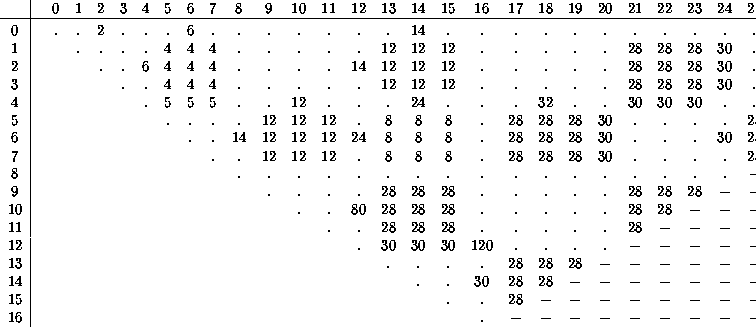Examination of the data sections shows increasingly large numbers of
cycles of period 4, all arising by combining unit cells of the form
![]() (and thus of individual lengths g+G+2) in all possible
ways to form the circumference N. Some of these produce
configurations of period 4, but other periods such as 24 and 28, which
occur frequently, arise the same way. G and g represent
gaps---sequences of zeroes---of the corresponding lengths. There are
certain restrictions on combinations of gap lengths; most result in the
formation of enneads with differing periods, with a good variety of
other combinations. However some mixtures are not periodic,
degenerating into other cycles or even into the quiescent state.
(and thus of individual lengths g+G+2) in all possible
ways to form the circumference N. Some of these produce
configurations of period 4, but other periods such as 24 and 28, which
occur frequently, arise the same way. G and g represent
gaps---sequences of zeroes---of the corresponding lengths. There are
certain restrictions on combinations of gap lengths; most result in the
formation of enneads with differing periods, with a good variety of
other combinations. However some mixtures are not periodic,
degenerating into other cycles or even into the quiescent state.
The following table shows the admissible periods as a function of G
and g, but symmetry implies that it is only necessary to consider ![]() . Dots indicate combinations which evolve into cycles from which
they are absent. Dashes indicate combinations outside of the range of
our study.
. Dots indicate combinations which evolve into cycles from which
they are absent. Dashes indicate combinations outside of the range of
our study.
0.1em

Since the antidiagonals of this table contain configurations of a fixed circumference, the periods arising from these structures can be read off for a ring of length N quite directly. It has to be borne in mind that there are many conjugate pairs, for example the combination (1,6) of period 4 evolves into (2,4) in two generations, which in turn evolves into (1,6) in two more generations to complete the period. It is the number of conjugate sets which is given in the tables, not the number of individual configurations.
Exploring the enneads further, their periods are found to have the form
![]() , although the values of k do not necessarily follow in strict
numerical succession. The tables show enneads for k=3,4,5, but there
are two distinct enneads with the last value. The structures filling
the interstices between the enneads follow a much less evident pattern.
, although the values of k do not necessarily follow in strict
numerical succession. The tables show enneads for k=3,4,5, but there
are two distinct enneads with the last value. The structures filling
the interstices between the enneads follow a much less evident pattern.
Similar tables can be constructed for other pairs of simple isolated structures, such as a pairs or triples of cells; indeed some such combinations can be recognized in the tables. However, the results obtained are not nearly as comprehensive as for individual cells. Even the table shown requires further analysis to deduce its general structure and ensure that it applies equally well for all the cases not determined empirically.